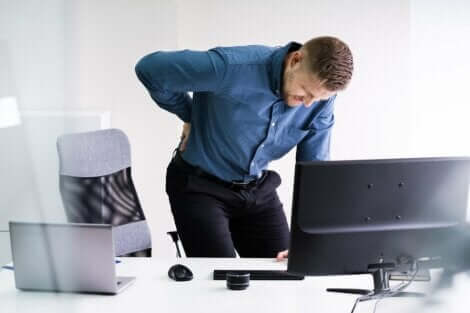Exercises to Avoid with a Herniated Disc

Although exercise seems to be a good way to treat back issues, there are some exercises to avoid with a herniated disc, due to the complexity of this condition. As researchers explain in this article published in Current Reviews in Musculoskeletal Medicine, herniated discs are one of the main contributors to back pain.
Although at first signs of injury it is advisable to rest to avoid further complications, after a few days light exercise becomes essential as a means to activate the muscles. In general, this reduces the pressure on the discs, strengthens the core, and can even help you maintain a healthy weight.
Still, you should keep in mind that not all exercises are appropriate for treating herniated discs. So, which exercises should you avoid and why? Below we’ll share three of our recommendations.
What is a herniated disc?
Before we begin, it’s important to explain that spinal vertebrae are separated by cartilaginous discs. These discs serve as shock absorbers and are responsible for preventing friction between the bones. Additionally, they act as ligaments and provide flexibility and mobility to the spine.
Discs consist of two parts, each of which has a specific function. Below we’ll see what these functions are:
- The nucleus: the central part of the disc that absorbs the pressure between the vertebrae.
- The ring: the outer part of the disc that limits rotation.
Herniated discs happen when the nucleus is compressed and extends outwards due to a tear in the ring. Consequently, this can cause discomfort or pinch a nearby nerve, which can result in either pain or numbness.
Possible causes of a herniated disc can include:
- Natural degeneration from aging
- Bad movements or physical overexertion
- Trauma
- Excessive weight and obesity
- Type of work (involving activities of high physical demand)
- Physical activity or sports
Pain relievers, rest, lifestyle changes, and specific exercises are all methods of treating herniated discs. In rare cases, it may require a surgical procedure. Regardless of the severity, you should take certain precautions such as avoiding some exercises.

Read more: Symptoms of a Herniated Disc
Exercises to avoid if you have a herniated disc
Multiple studies in the International Journal of Sports Physical Therapy recognize the importance of exercise as part of herniated disc rehabilitation protocols. Of course, you should only follow a training regime specific to your injury, and, make sure you take into account these exercises to avoid with a herniated disc:
1. Weightlifting
First off, you should stay away from any exercises that put pressure on the vertical axis of the spine. This is what happens with squats, which you do by bending the knees as if sitting on a chair, usually while holding a barbell behind the neck.
Similarly, we don’t recommend any exercises where you hold weights above your head like in the overhead press, otherwise known as the military shoulder press. In this exercise, you grab the barbell with a prone grip shoulder-width apart. Then, you bring the bar shoulder height and press it up, overhead, by extending the elbows.
These exercises, especially when you involve weights, require the spine remain straight in order to support the full impact of the weight. Because of this, they are considered dangerous and should be avoided if you are suffering from a herniated disk.
Alternative exercises
Front squats are a good alternative to take the pressure off the lower back while still activating the core and other important muscles. In other words, front squats keep the weight at the height of the clavicle and not behind the head. Still, it’s best to avoid doing any type of squat with weights until the herniated disc has healed.
On the other hand, if you’re looking to develop more muscle volume, you can opt for the squat press machine. In this exercise, you support the weight with your legs and, when you’re seated correctly with your glutes on the chair, you limit the impact on your lower back as you press the weight away from you.
Similarly, you can do lat rows as an alternative to the military press. To accomplish this, you support your knee and one hand on a bench while holding a weight in your other hand. Keeping your core engaged and your back straight, you pull your elbow up to your side. This way, the pressure is evenly distributed and has little effect on the lower back.
2. Abdominals
In herniated disc injuries that occur in the lower back, the sciatic nerve is often affected as well. Because of this, you might experience pain extending from the waist towards the hips, buttocks, and legs.
Now, most abdominal exercises force the lower spine to flex and create tension on that spot. This tension occurs both in ab exercises in which you raise the torso (upper abdominal) and in those in which you lift your legs (lower abdominal).
Therefore, abdominal exercises should be avoided entirely, with or without added weight. Even exercises that are done with special machines aren’t recommended as they naturally flex the lower back in order to maintain good posture.
Alternative ab exercises
Planks are the best alternatives to engage the muscles in your core. Planks allow you to strengthen your abductor while keeping the spine in a neutral position. There are various types of plank exercises, as well. The ones with the least impact are the following:
- Anaerobic plank. This is done face down, holding your weight over your forearms and balls of the feet in order to maintain the body in a horizontal position.
- Side plank. Laying on your side with your feet together, lift your body up so you’re supporting yourself on your elbow, positioned directly below your shoulder. Maintain the position for a few seconds.

3. Stretches, rotations, and hyperextension
Spinal stretches, rotations, and extensions are often an ideal way to start a workout. However, when treating a lumbar disc herniation, you need to exercise caution.
Stretches that instruct you to bring your knees to your chest or touch your toes while your legs are fully extended can aggravate the injury. This is because the position can create more stress and friction on the discs. And, if you have a herniated disc, this isn’t an area that should bear weight or pressure.
Alternative stretches
An alternative to avoid impacting the spine too much is to perform stretches while lying down, as you would do in the piriformis stretch, for example. This way, you’re strengthening your spine in addition to working the muscles around the spine and reducing tension in the lower back.
The oblique crunch, which you also do while lying down, is a safe exercise to stretch your legs. While lying on your back on a mat with your legs bent, you bring your knees to the left and to the right alternately.
Discover: How to Distinguish a Herniated Disc from Common Back Pain
Is it good to exercise with a herniated disc?
Having a herniated disc doesn’t mean you can’t be active. On the contrary, we recommend you continue to do physical activity, though with some precautions. It’s important to remember the above exercises to avoid with a herniated disc, and two key factors: low weight, and no pressure on the spine.
The most important thing when treating a herniated disc is to refrain from a sedentary lifestyle, as this is usually counterproductive to this type of injury. Of course, ideally, you would exercise with a professional trainer or physiotherapist to prevent bad form and risk further injury. In addition, you can do low-impact activities such as yoga, swimming, or Pilates.
All cited sources were thoroughly reviewed by our team to ensure their quality, reliability, currency, and validity. The bibliography of this article was considered reliable and of academic or scientific accuracy.
- Amin RM, Andrade NS, Neuman BJ. Lumbar Disc Herniation. Curr Rev Musculoskelet Med. 2017;10(4):507-516. doi:10.1007/s12178-017-9441-4
- Blasimann A, Eberle S, Scuderi MM. Effekt eines Rumpfkräftigungsprogramms (inklusive Unterarm- und seitlichem Unterarmstütz) auf die Verletzungsrate von erwachsenen Fußballspielern: eine systematische Literaturübersicht [Effect of Core Muscle Strengthening Exercises (Including Plank and Side Plank) on Injury Rate in Male Adult Soccer Players: A Systematic Review]. Sportverletz Sportschaden. 2018 Mar;32(1):35-46. German. doi: 10.1055/a-0575-2324. Epub 2018 Mar 20. PMID: 29558776.
- Duffoo Olvera N, Dufoo Villegas M, Preciado Salgado M. Criterios de tratamiento de la hernia discal aislada y de hernias discales múltiples. Ortho-tips 2005; 1(2): 77-93.
- Gálvez M, Cordovez J, Okuma C, Montoya C, Asahi T. Diagnóstico diferencial de hernia discal. Revista Chilena de Radiología, 2017; 23(2): 66-76.
- Krivoy, A., Krivoy, J., & Krivoy, M. (2005). El fumar y la columna vertebral quirúrgica. Gac. méd. Caracas, 193-198.
- Mera, L. R. L., Moreira, M. T. S., & Almea, M. D. V. (2016). Consideraciones generales acerca de las hernias discales lumbares: Terapia ocupacional. Dominio de las Ciencias, 2(3), 175-186. https://dialnet.unirioja.es/servlet/articulo?codigo=5856496
- Moley J. Hernia del núcleo pulposo (Hernia, rotura o prolapso del disco intervertebral). MSD Manuals [En línea]. 2019 [Fecha de acceso: 04 de octubre de 2020]; disponible en: https://www.msdmanuals.com/es-ve/professional/trastornos-de-los-tejidos-musculoesquel%C3%A9tico-y-conectivo/dolor-de-cuello-y-espalda/hernia-del-n%C3%BAcleo-pulposo
- Sánchez-Pinilla, R. O. (2020). ¿ Cuáles son los ejercicios indicados en la lumbalgia crónica y en la hernia discal?. FMC-Formación Médica Continuada en Atención Primaria, 27(1), 34-46. https://www.sciencedirect.com/science/article/abs/pii/S1134207219302142
- Silberman F, Varaona O. Ortopedia y Traumatología, 3era ed. Buenos Aires: Editorial Médica Panamericana, 2010.
- Vásquez-Ríos J, Nava-Bringas T. Ejercicios de estabilización lumbar. Cirugía y Cirujanos, 2014. 82(3): 352-359.
This text is provided for informational purposes only and does not replace consultation with a professional. If in doubt, consult your specialist.








